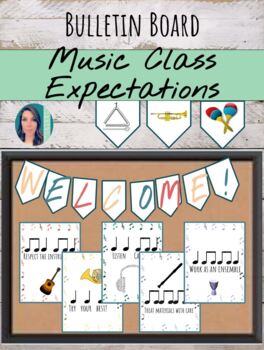Here's my secret: I don't have any rules in music class.
We've all been there. Day #1 of class where rules are the top priority for a teacher, making zoning out the top priority for the students.
As students, we didn't love it. And I'd be willing to bet that as teachers, we still don't love it.
SO change.
I mean it when I say it: My secret to an awesome music class is having no rules.
Expectations
What is the purpose of a rule? Most of the time, a rule is something that, when broken, has a consequence.
In order to have rules & consequences, you'll spend your time enforcing them & doling out punishments. Have you heard this one:
"If you play before I say, I will take your instrument away."
It rhymes, it's catchy, & gets to the point quickly. But I don't use it for 2 reasons:
- It is not student-led, meaning that it doesn't give students permission to play at a certain time, but rather steals their autonomy.
- It makes the teacher the villain. And while villains have epic songs (think of Scar, Ursula, or Hades!) , it's not a great vibe for your classroom.
- Watch the conductor
- Breathe together
- Blend in
- Stay in tempo
Routines
Having routines & procedures helps the class run smoothly. Instead of rules about what to touch vs what not to touch, or sitting silently waiting for attendance, or even no rules until the bell rings, setting up daily routines is a life-saver!
In K-2 music classes, classes are formulaic.
- Welcome to Music song (Freebie)
- Lesson: song with a targeted skill such as Baby Bumblebee to practice keeping a steady beat
- Movement activity to accompany song or reinforce skill (Gotta love actions to accompany simple songs like this)
- Review - While K-1 may review best by creating silly actions or reviewing the sequencing of the song or sharing stories, 2nd graders would be able to compose by counting syllables such as this worksheet
Line up & leave. I use these movement cards during transitions to help students leave music class while practicing a steady beat & rhythmic chants. It also helps with behavior & to showcase emerging skills to homeroom teachers. It's a great way to advocate for your class because music is not just someone else's prep time!
In 3rd-4th grade music classes, I have either a sight singing pattern or a rhythm to sight read on the board.
- Students come in & clap or sing
- Students are instantly engaged
- Students get additional time practicing musical skills.
- Instrument(S)
- Tune instruments if applicable
- Grab stands to share
- Bring out sheet music, folders, or binders.
Values
At the core of your class, what is the central belief?
For those of you feeling brave, invite your students to create core classroom values. Writing out those beliefs is helpful for reference & can also be used as reminders when students are not embodying those behaviors.
Perhaps this looks like beautiful posters, bulletin boards, or classroom wall art. Here are some of my favorites:Celebrate being different , being a family, & being respected.
Consider applying this to your choirs, bands, & orchestras!
Performance Ensembles benefit from routines as well. Give yourself a leg up with these sign up forms, schedule, or attendance sheets. For advanced choirs, they may even be able to start warm ups by themselves! For reference, my Middle School choir starts 1-1-2-1 independentlyWhat feels most authentic to you? Rules? Routines? Values? or Expectations? Let me know in the comments below!







Comments
Post a Comment
If you have a Google account (such as Youtube, Gmail, Google Apps, Google+, Blogger), feel free to leave a comment or words of encouragement here! If you don't have a way to sign in, you can still leave a message on the main page under the 'Leave Jaime a Message' title on the right side of the page, below the calendar!